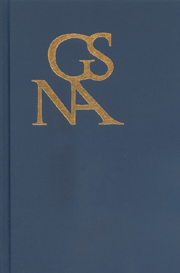Book contents
- Frontmatter
- Contents
- Presidential Address (December, 2004) Schiller vs. Goethe: Revisiting the Conflicting Reception Vectors of Heinrich Heine, Ludwig Börne, and Wolfgang Menzel
- Goethe's Mixed Media: The Entertainers in Jahrmarktsfest zu Plundersweilern
- Goethe's “Ilmenau” and the Origins of the Aesthetic State
- Familial Politics and Political Families: Consent, Critique, and the Fraternal Social Contract in Schiller's Die Räuber
- Paintings in Goethe's Wilhelm Meister Novels: The Dynamics of Erecting and “Eroding” the Paternal Law
- “Waldplatz,” “Wahlplatz”: Miszelle zur Golgatha-Konnotation einer Episode in Wilhelm Meisters Lehrjahre
- Shocks from a Sicilian Underworld: Gangi,“Gänge,” and a New Source for the “Mütter” in Goethe's Faust
- “Feuer brennen blau”: Rethinking the Rainbow in Goethe's Faust
- Cosmopolitanism and Weltliteratur
- “Von jedem öffentlichen Wirken in Deutschland ausgeschloßen”: Ein Brief Ottilie von Goethes an Sarah Austin (4. Aug. 1840)
- Book Reviews
Goethe's Mixed Media: The Entertainers in Jahrmarktsfest zu Plundersweilern
Published online by Cambridge University Press: 05 February 2013
- Frontmatter
- Contents
- Presidential Address (December, 2004) Schiller vs. Goethe: Revisiting the Conflicting Reception Vectors of Heinrich Heine, Ludwig Börne, and Wolfgang Menzel
- Goethe's Mixed Media: The Entertainers in Jahrmarktsfest zu Plundersweilern
- Goethe's “Ilmenau” and the Origins of the Aesthetic State
- Familial Politics and Political Families: Consent, Critique, and the Fraternal Social Contract in Schiller's Die Räuber
- Paintings in Goethe's Wilhelm Meister Novels: The Dynamics of Erecting and “Eroding” the Paternal Law
- “Waldplatz,” “Wahlplatz”: Miszelle zur Golgatha-Konnotation einer Episode in Wilhelm Meisters Lehrjahre
- Shocks from a Sicilian Underworld: Gangi,“Gänge,” and a New Source for the “Mütter” in Goethe's Faust
- “Feuer brennen blau”: Rethinking the Rainbow in Goethe's Faust
- Cosmopolitanism and Weltliteratur
- “Von jedem öffentlichen Wirken in Deutschland ausgeschloßen”: Ein Brief Ottilie von Goethes an Sarah Austin (4. Aug. 1840)
- Book Reviews
Summary
WITH HIS OWN WORKS, then and later, the early Goethe was famously cavalier, careless, forgetful,even incendiary. His autos-da-fé are the stuff of legend, and the unexpected reappearance of manuscripts like Satyros within his lifetime and, posthumously, of the Urfaust and Urmeister, seems equally phoenix-like and uncanny. A pronounced pattern of nonchalance and textual self-negligence indicates, among other things, a premedia approach to publishing in an age of pirating just on the cusp of the cult of celebrity. For those of us still wondering why Goethe went to Weimar, there might be a tell-tale clue here: a retreat into literary seclusion. There is less Byron and more than a little Salinger about the early Goethe.
In the case of Das Jahrmarktsfest zu Plundersweilern, Goethe was generous to a fault.This revue-like, carnivaleque farce was first published anonymously in 1774 in a collection entitled Neueröfnetes moralischpolitisches Puppenspiel. Goethe had donated the manuscript along with other works, including Pater Brey, to the penniless Sturm und Drang playwright Friedrich Maximilian Klinger, “möge er es zerreisen, hinlegen oder verkaufen wollen.” It is worth noting that these farces, along with the Shakespearean Götz and the epistolary novel Werther, encompassed the published, public Goethe before 1775.
- Type
- Chapter
- Information
- Goethe Yearbook 13 , pp. 19 - 52Publisher: Boydell & BrewerPrint publication year: 2005



